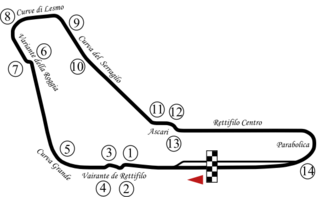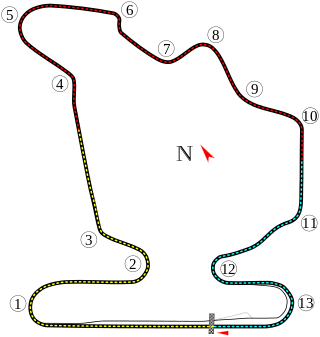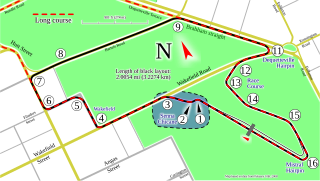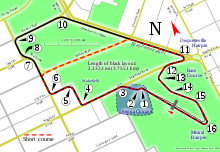
The 1986 Italian Grand Prix was a Formula One motor race held at Monza on 7 September 1986. It was the thirteenth race of the 1986 Formula One World Championship.

The 1987 Australian Grand Prix was a Formula One motor race held at Adelaide on 15 November 1987. It was the sixteenth and final race of the 1987 Formula One World Championship.

The 1988 Portuguese Grand Prix was a Formula One motor race held on 25 September 1988 at the Autódromo do Estoril, Estoril. It was the thirteenth race of the 1988 Formula One World Championship. The 71-lap race was won by Alain Prost, driving a McLaren-Honda, with Ivan Capelli second in a March-Judd and Thierry Boutsen third in a Benetton-Ford. Prost's teammate and Drivers' Championship rival, Ayrton Senna, could only manage sixth.

The 1988 Australian Grand Prix was a Formula One motor race held at the Adelaide Street Circuit on 13 November 1988. It was the sixteenth and final race of the 1988 Formula One World Championship, and the last race for which turbocharged engines would be eligible until the 2014 Australian Grand Prix.

The 1989 French Grand Prix was a Formula One motor race held at Paul Ricard on 9 July 1989. It was the seventh race of the 1989 Formula One World Championship.

The 1989 Belgian Grand Prix was a Formula One motor race held at Spa-Francorchamps on 27 August 1989. It was the eleventh race of the 1989 Formula One World Championship.

The 1989 Italian Grand Prix was a Formula One motor race held at Monza on 10 September 1989. It was the twelfth race of the 1989 Formula One season.

The 1989 Australian Grand Prix was a Formula One motor race held at Adelaide on 5 November 1989. It was the sixteenth and final race of the 1989 Formula One World Championship.

The 1990 Brazilian Grand Prix was a Formula One motor race held at Interlagos, São Paulo on 25 March 1990. It was the second race of the 1990 Formula One World Championship. It was also the first Brazilian Grand Prix to be held at Interlagos since 1980, following the renovation and shortening of the circuit and the ascendancy of São Paulo driver Ayrton Senna.

The 1990 San Marino Grand Prix was a Formula One motor race held on 13 May 1990 at Imola. It was the third race of the 1990 Formula One World Championship. The race was held over 61 laps of the 5.04-kilometre (3.13 mi) circuit for a race distance of 307.44 kilometres (191.03 mi).

The 1990 German Grand Prix was a Formula One motor race held at the Hockenheimring on 29 July 1990. It was the ninth race of the 1990 Formula One World Championship. The race was the 52nd German Grand Prix and the 14th to be held at the Hockenheimring. It was the 39th and last Formula One Grand Prix to be held in West Germany prior to its re-unification with East Germany. The race was held over 45 laps of the seven kilometre circuit for a race distance of 306 kilometres.

The 1990 Hungarian Grand Prix was a Formula One motor race held at Hungaroring on 12 August 1990. It was the tenth race of the 1990 Formula One World Championship. The race was the sixth Hungarian Grand Prix and the fifth to be held at the Hungaroring. It was held over 77 laps of the 3.97-kilometre (2.47 mi) circuit for a race distance of 305.5 kilometres (189.8 mi).

The 1991 Italian Grand Prix was a Formula One motor race held at Monza on 8 September 1991. It was the twelfth race of the 1991 Formula One World Championship.

The 1991 Japanese Grand Prix was a Formula One motor race held at Suzuka on 20 October 1991. It was the fifteenth round of the 1991 Formula One season. The 53-lap race was won by McLaren driver Gerhard Berger after he started from pole position. His teammate Ayrton Senna finished second and Riccardo Patrese was third for the Williams team. The race would mark Mclaren's last one-two finish for six years until the 1997 European Grand Prix.

The 1991 FIA Formula One World Championship was the 45th season of FIA Formula One motor racing and the 42nd season of the Formula One World Championship. It featured the 1991 Formula One World Championship for Drivers and the 1991 Formula One World Championship for Constructors, which were contested concurrently over a sixteen-race series that commenced on 10 March and ended on 3 November.

The 1990 FIA Formula One World Championship was the 44th season of FIA Formula One motor racing. It featured the 1990 Formula One World Championship for Drivers and the 1990 Formula One World Championship for Constructors, which were contested concurrently over a sixteen-race series that commenced on 11 March and ended on 4 November. Ayrton Senna won the Drivers' Championship for the second time, and McLaren-Honda won their third consecutive Constructors' Championship.

The 1989 FIA Formula One World Championship was the 43rd season of FIA Formula One motor racing. It began on 26 March and ended on 5 November. Alain Prost won his third Drivers' Championship, and McLaren won the Constructors' Championship.

The 1987 FIA Formula One World Championship was the 41st season of FIA Formula One motor racing. It featured the 1987 Formula One World Championship for Drivers and the 1987 Formula One World Championship for Constructors, which were contested concurrently over a sixteen-race series that commenced on 12 April and ended on 15 November.

The 1986 FIA Formula One World Championship was the 40th season of FIA Formula One motor racing. It featured the 1986 Formula One World Championship for Drivers and the 1986 Formula One World Championship for Manufacturers, both of which commenced on 23 March and ended on 26 October after sixteen races. The Drivers' Championship was won by Alain Prost, Prost was the first driver to win back-to-back Drivers' Championships since Jack Brabham in 1959 and 1960. Together with Prost, Nigel Mansell, Nelson Piquet and Ayrton Senna dominated throughout the season and formed what was dubbed as the "Gang of Four".

The Adelaide Street Circuit is a temporary street circuit in the East Parklands adjacent to the Adelaide central business district in South Australia, Australia.

















